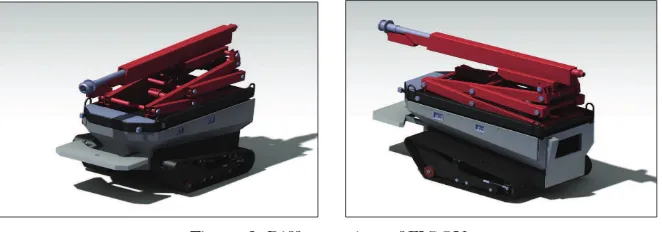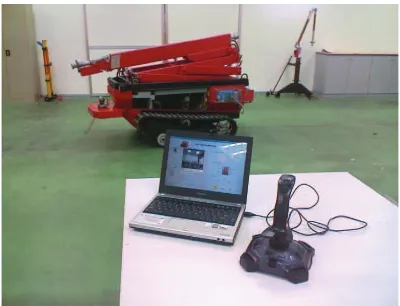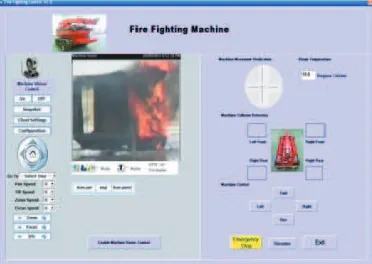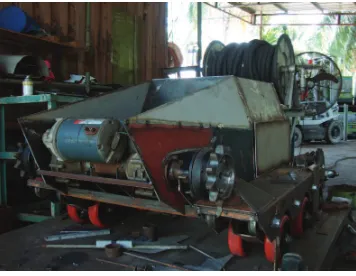PENYELIDIKAN
PROSIDING SEMINAR
HASIL
PENYELIDIKAN
MEMACU TRANSFORMASI
Jilid III
ICT dan Kejuruteraan
disunting oleh
PENYELIDIKAN
PENYELIDIKAN
MEMACU TRANSFORMASI
PENYELIDIKAN
PROSIDING SEMINAR
HASIL
Jilid I
Sains Sosial dan Kemanusian
disunting oleh
ABDUL GHAFAR ISMAIL
ROOSFA HASHIM
PENYELIDIKAN
PROSIDING SEMINAR
HASIL
Cetakan Pertama / First Printing, 2012
Hak cipta / Copyright Kementerian Pengajian Tinggi, 2012
Hak cipta terpelihara. Tiada bahagian daripada terbitan ini
boleh diterbitkan semula, disimpan untuk pengeluaran atau ditukarkan ke dalam sebarang bentuk atau dengan sebarang alat juga pun, sama ada dengan cara elektronik, gambar serta rakaman dan sebagainya
tanpa kebenaran bertulis daripada Kementerian Pengajian Tinggi terlebih dahulu.
All rights reserved. No part of this publication may be reproduced or transmitted in any form or by any means, electronic or mechanical including photocopy, recording, or any information storage and
retrieval system, without permission in writing from Ministry of Higher Education.
Diterbitkan di Malaysia oleh / Published in Malaysia by
KEMENTERIAN PENGAJIAN TINGGI No. 2, Menara 2, Jalan P5/6, Presint 5 62200 Putrajaya, Malaysia
Atur huruf oleh / Typeset by
REKA CETAK SDN BHD
284
Prosiding Seminar Hasil Penyelidikan Kementerian Pengajian Tinggi
30
Ground Vehicle for Fire Fighting Purpose in
Hazardous Environment
CHEE FAI TAN1*, MOHD. RIZAL ALKAHARI1, S.M. LIEW3, M.R. SAID1, S.S.S. RANJIT2, V.K. KHER1
1Integrated Design Group, Faculty of Mechanical Engineering,
Universiti Teknikal Malaysia Melaka, Melaka, Malaysia
2Faculty of Electronics and Computer Engineering,
Universiti Teknikal Malaysia Melaka, Melaka, Malaysia
3Rirtz Power Mechanics Sdn. Bhd., Malaysia
*E-mail: [email protected] ABSTRACT
In this project, design, development and performance of a wirelessly controlled Fire Fighting Ground Vehicle (FIGOV) is described. FIGOV is a wireless control mobile machine that is equipped with firefighting equipment. It carries high density camera, sensors, communication equipment, firefighting equipment and other loads in order to control fire and perform victim searching task. The machine is wirelessly controlled via mobile computer. The nozzle of the machine can be directed at different angle and can be elevated in order to control fire at different height. FIGOV can be used to reduce the risks faced by fire fighters in performing their duties. This is due to the fact to the current fire fighting techniques require fire fighters to intervene in hazardous conditions. Working at very high temperature, dusty, low humidity, dangerous and others are among usual working conditions associated with fire fighting. Study conducted showed that the machine can be successfully be used in real fire fighting process. Effective use of the machine also can avoid direct contact of human especially fire fighter with radioactive or hazardous materials that may have immediate or long-term effects on health as well as fatigue to human.
Keywords: Fire fighting, robot.
INTRODUCTION
Fire fighting is risky profession. They are not only extinguishing fires in tall buildings but also must drag heavy hoses, climb high ladders and carry people from buildings and other situations. There are many fire fighters lost their lives in the line of duty each year throughout the world. The statistics of the fire fighter fatalities are still maintain at high level every year and it may continue to increase if there is no improvement in fire fighting techniques and technology. In addition to working in long and irregular hours and unfriendly working environment such as high temperature, dusty and low humidity, firefighters are also facing with potentially life threatening situation such as explosion, collapsed building and radioactive. The common equipment used by firefighters such as flat head axe, halligan bar, turnout jacket, fire retardant or bunker pants, boots, flashlight, helmet, face mask, and gloves do not significantly reduce risk on their lives when facing those life threatening situations.
285
Prosiding Seminar Hasil Penyelidikan Kementerian Pengajian Tinggi
the fire fighter risk. The machines help the fire fighter using extinguishing agent such as water, foam or others without fire fighter having to set up or operate directly in danger areas. Amano (2002) highlighted the weaknesses of existing machine design and suggest integration of all important elements in developing fire fighting machine so that a successful rescuing process can be achieved. These elements are size, weight, cost and performance. Therefore, this research integrates required technical aspects and develops a machine based on the end user requirements which is fire fighting rescue team.
The developed of FIGOV is a remotely controlled machine consists of a mobile and rigid chassis. The machine is wirelessly controlled via mobile computer. The nozzle of the machine can be directed at different angle and can be elevated in order to control fire at different height. One of the great importance of the development of the Fire Fighting Machine is it can reduce the risks faced by fire fighters in performing their duties. This is due to the fact to the current fire fighting techniques require fire fighters to intervene in hazardous conditions. Working at high temperature, dusty, low humidity, dangerous and others are among usual working conditions associated with fire fighting. The FIGOV system is a ground vehicle that can move fast, light weight, able to rescue people, equipped with long-range control ability for firefighting and rescue purpose. The FIGOV is capable of fire fighting and rescue purpose in a small and hazardoud environment. In addition, the FIGOV is using green energy, which is electric, to power the machine. The FIGOV is equipped with state of the art sensor and imaging system to detect and locate fire victim. The first generation of FIGOV was developed in the year 2006. In the development of the FIGOV, the project was received the research grants from university (Short Term Research Grant) and Ministry of Higher Education, Malaysia (Fundamental Research Grants Scheme). The research research grants was used to study the mobility and wireless monitoring of the FIGOV. Recently, the project successfully received the Prototyping Research Grants Scheme from Ministry of Higher Education, Malaysia. Besides, the project is the collaboration project between university and industry. The company focused on the mechanical structure and mechanism fabrication of the FIGOV. The FIGOV was won the Gold medal in 20th ITEX in Kuala Lumpur and Brussels INNOVA 2009. Currently, the up-scaling process for 4th generation FIGOV is in progress. In
this paper, we will describes the development of FIGOV that focus on design, analysis as well as experimental aspects.
1ST GENERATION OF FIRE FIGHTING GROUND VEHICLE
The first generation of FIGOV (Figure 1) was developed in year 2005. It si equipped with elevated arm, a motorized crane hook system and two compressed water tanks.
286
Prosiding Seminar Hasil Penyelidikan Kementerian Pengajian Tinggi
2ND GENERATION FIRE FIGHTING GROUND VEHICLE
Figure 2 shows the completed solid model design of FIGOV using Computer Aided Design (CAD) modeling.
Figure 2: Solid Modeling of FIGOV
All parts are drawn and assembled using Solidworks software. The detail design which is developed using CAD software will be analyzed further to prove that the design satisfy the engineering requirement. Figure 3 shows different view of FIGOV.
Figure 3: Different view of FIGOV
Detail design of all assembled components is prepared. These parts are then visually assembled in Figure 4. Figure 5 shows the exploded drawing of FIGOV. Bill of Material (BOM) is also prepared and listed since it is needed before the fabrication.
287
Prosiding Seminar Hasil Penyelidikan Kementerian Pengajian Tinggi
Figure 5: Exploded drawing of FIGOV
Design of Machine Control System and Computer Interfacing
The developed prototype can be controlled wirelessly via mobile computer. Therefore, special dedicated software is developed in order to interface the machine and the computer. Additional control mechanism is added by integrating the system with a joystick in order to ensure the mobility control can be improved. Figure 6 shows the machine and its controller which is a mobile computer and a joystick attached to the computer. Visual Basic Programming language is used in the developing the program that interface the machine with computer. The system developed enable machine operator to monitor the condition where the machine is located as there is a camera attached to the machine. Two way communication also possible between the victim in the fire ground and the machine operator as there is internal microphone integrated with the system.
Figure 6: FIGOV and its Controller
288
Prosiding Seminar Hasil Penyelidikan Kementerian Pengajian Tinggi
the machine is also equipped with communication equipment where two way communication is possible between the victim and rescuer who control the machine. Any potential of crash can be detected automatically through Machine Collision Detection area where the system will signify through blipping sound and blinking indicator.
Figure 7: Windows Interface for Controlling the FIGOV
Final Prototype and Engineering Specification
Final prototype of FIGOV is prepared with some design changes during the fabrication stage. Nevertheless, the design changes are not critical and still follow the main design as planned. Figure 8 and Figure 9 show the side view and isometric view of the final prototype of FIGOV. The engineering specification of final design FIGOV is as given in Table 1.
Figure 8: Side View of Final Prototype of FIGOV
289
Prosiding Seminar Hasil Penyelidikan Kementerian Pengajian Tinggi
Table 1: General specifications of the FIGOV
Hardware Specification
Suspension N/A
Track System Heavy duty rubber track belt Electrical 22V
Engine Electric DC Motor by Sanpo Electric Co. LTD. Engine Power 750 W
Engine Current 46 A
Engine Speed 1900 rpm or 198.97 rad/s Torque 3.77 N.m
Transmission 2 speed. Manually changed. Curb weight 910 kg
Maximum Speed 2.36 km/h
3RD GENERATION FIRE FIGHTING GROUND VEHICLE
The 3rd generation of FIGOV was developed and built in the year 2009. The FIGOV was
redeveloped to improve the mobility as well as the mechanical structure. Two electric motors were used to drive the FIGOV but having the problem of synchronization for both right and left track. After the analysis and testing, the FIGOV need to be redesigned for better mobility and have lighter structure. Figure 10 shows 3rd generation of FIGOV in progress.
Figure 10: the 3rd generation of FIGOV
CURRENT DEVELOPMENT OF 4TH GENERATION FIRE FIGHTING GROUND VEHICLE
Currently, the 4th generation of FIGOV is up scaling process. The new design of the FIGOV will
290
Prosiding Seminar Hasil Penyelidikan Kementerian Pengajian Tinggi
Figure 11: the conceptual sketch
SUMMARY
The paper describes the development of Fire Fighting Ground Vehicle as well as the results from previous study. The project is a collaboration project between university and industry. The constraints of the project are limited budget and longer procurement process. The researcher needs to plan and control the budget so that the FIGOV project able to complete in time. For the procurement process, some of the components need to be customized and manufactured as well as to be ordered from oversea. The up-scaling FIGOV prototype able to enhance quality of life for fire fighthers as well as saving life in harzardous environment such as chemical and radiative hazard environment. In addition, FIGOV also able to save public investment by fire fighting and safe guard public property. The FIGOV system can be redesign for different usage by using the same control and base system, such as defense, suivellence, recreation, training and industry. The state of the art FIGOV can become an industry that can generate knowledge, create jobs and promote entrepreneuship.
ACKNOWLEDGEMENT
291
Prosiding Seminar Hasil Penyelidikan Kementerian Pengajian Tinggi
REFERENCES
Anna Konda – The Fire Fighting Snake Robot. Europe. Available from: http://www.sintef.com. Accessed on 4th September 2008.
Eric Sofge. 2007. First Firefighting Robots Deployed, Could Spark Autonomous Dept. Las Vegas. Available from: http://www.popularmechanics.com/science/roboticsl. Accessed on 5th September 2008. Hisanori Amano. 2002. Present Status and Problems of Fire Fighting Robots. SICE 2002.Proceedings of
the 41st SICE Annual Conference,5-7 Aug. 2002, Volume 2, page 880- 885.
HKFSD. Mobile Fire Fighting Supporting Machine LUF 60R. China. Available from: http://www.hkfsd. gov.hk/home/images/ equipment/fire/e_luf60.html. Accessed on 13th September 2008.
International Association of Fire Fighters (IAFF). 2000. Death and Injury Survey,Washington. Available from: http://www.iaff.org/HS/PDF/2000%20D&I.pdf. Accessed on 5th September 2008.
NEVA. Mobile Fire Fighting Robot. Russia. Available from: http://www.neva.ru/CNII-RTC/Firemen/html. Accessed on 13th September 2008.
Alkahari, R., Abd. Kadir, M., Mohammad Nasir, M.Z., Abdul Rahman, M.N., Tan, C.F. 2009. Fundamental Study on the Performance of a Remotely Controlled Fire Fighting Machine for use in Hazardous Fire. Unpublished FRGS Report, UTeM.
Rosmuller, N., Ale, B.J.M. 2008. Classification of fatal firefighter accidents in the Netherlands: Time pressure and aim of the suppression activity, Journal of Safety Science, 46, page 282 –290.
Shanghai Qiangshi Fire-fighting Equipment co., Ltd. 2007. Qiangshi Fire Fighting Robot, China. Available from: www.qs119.com/en/showpro.asp?id=530. Accessed on 5th September 2008.





